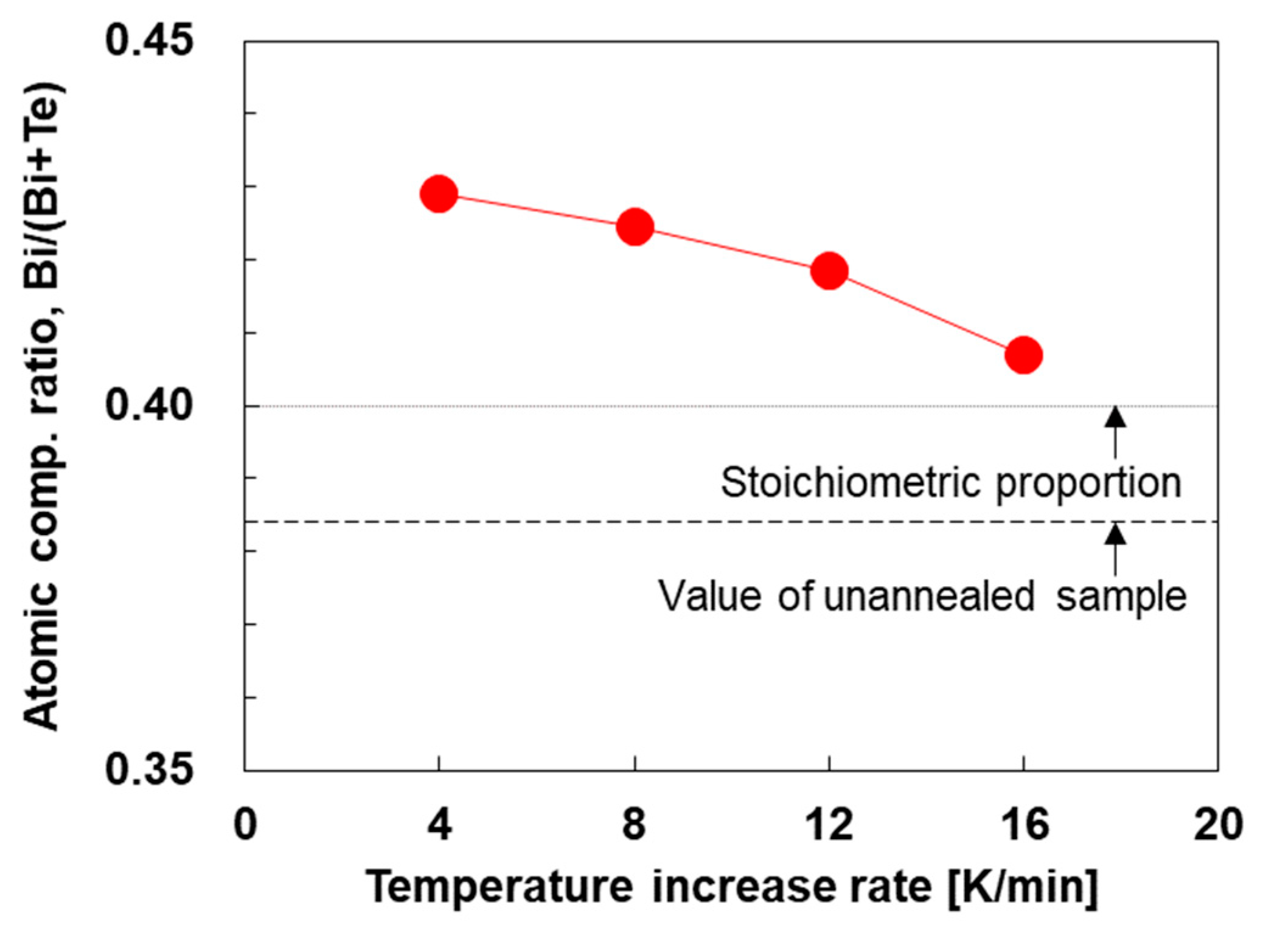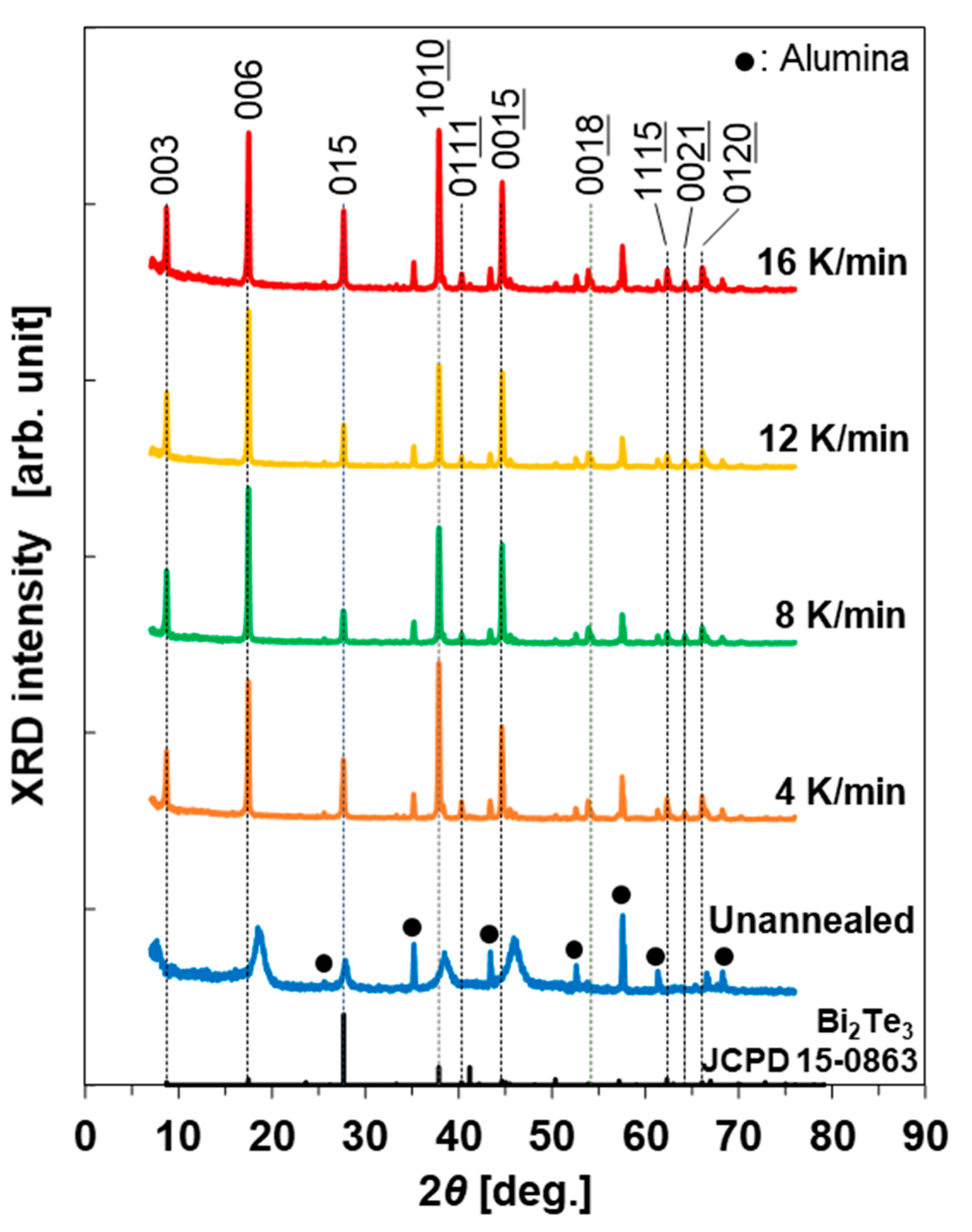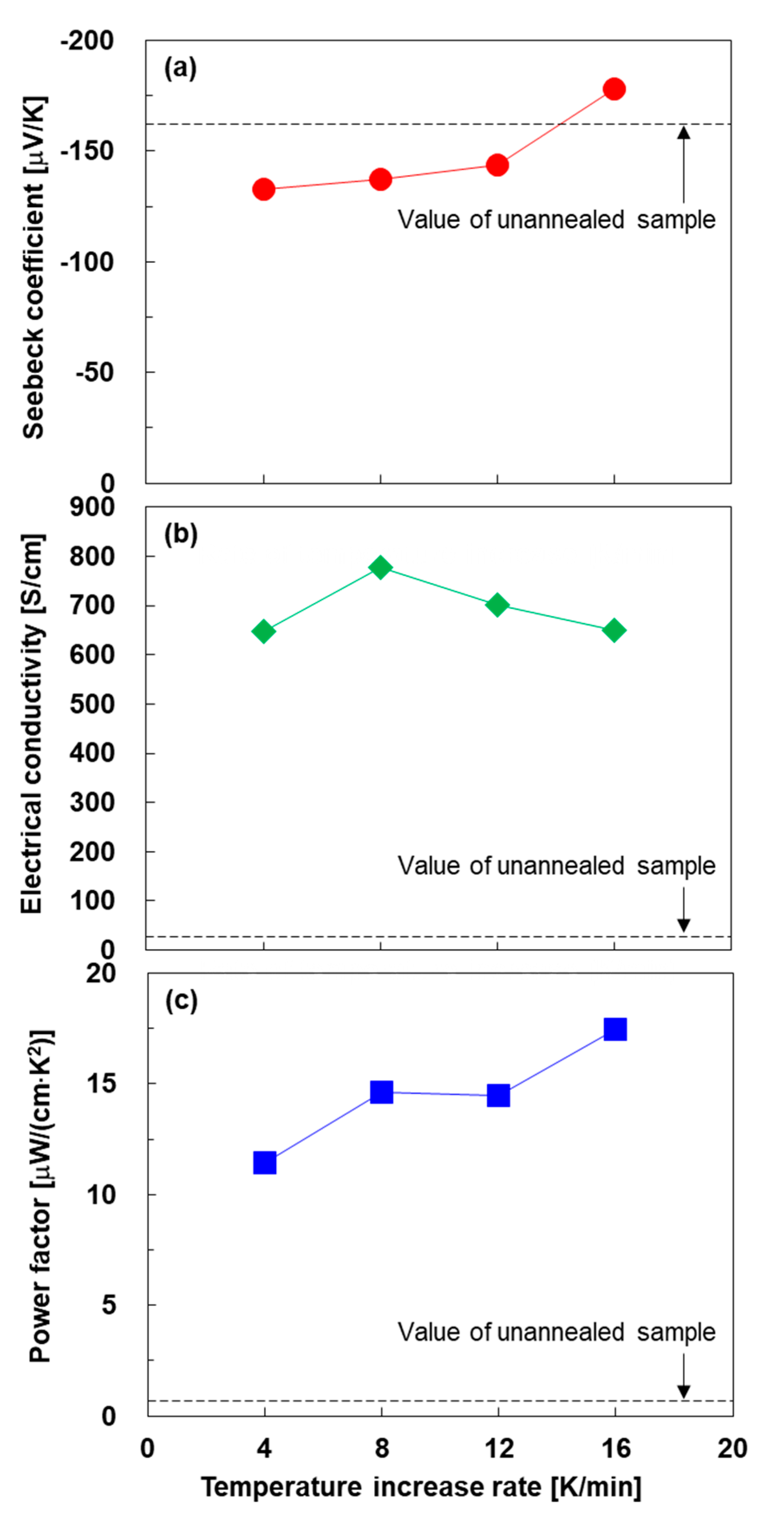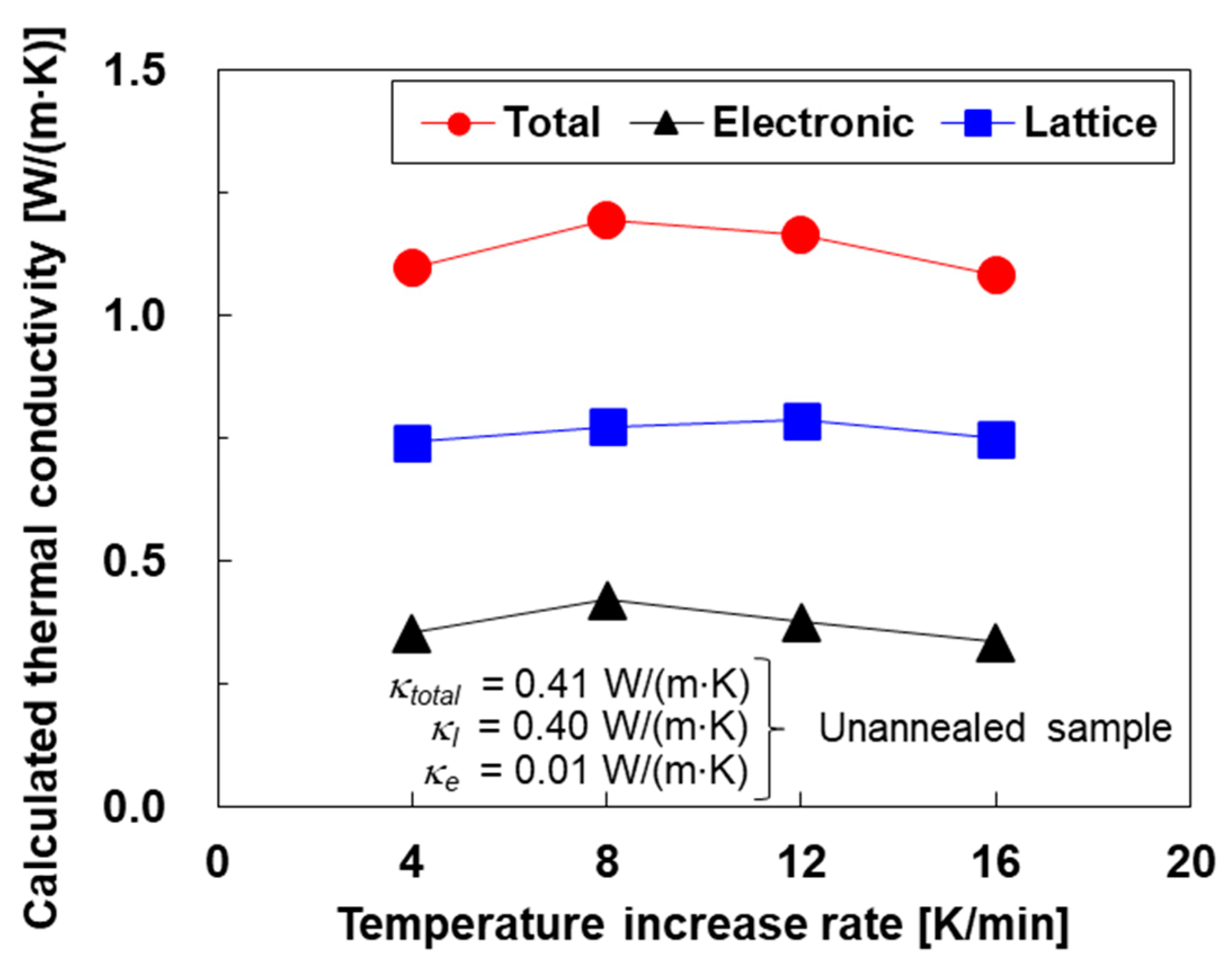Evaluation of Thermoelectric Performance of Bi2Te3 Films as a Function of Temperature Increase Rate during Heat Treatment
Abstract
:1. Introduction
2. Materials and Methods
3. Results
3.1. Structural Characteristics of the Bi2Te3 Thin Films
3.2. Electrical Transport Characteristics of the Bi2Te3 Thin Films.
3.3. Thermal Transport Characteristics of the Bi2Te3 Thin Films
3.4. Dimensionless Figure of Merit of the Bi2Te3 Thin Films
4. Conclusions
Author Contributions
Funding
Acknowledgments
Conflicts of Interest
References
- Venkatasubramanian, R.; Siivola, E.; Colpitts, T.; O’Quinn, B. Thin-film thermoelectric devices with high room-temperature figures of merit. Nature 2001, 413, 597–602. [Google Scholar] [CrossRef]
- Hinterleitner, B.; Knapp, I.; Poneder, M.; Shi, Y.; Müller, H.; Eguchi, G.; Eisenmenger-Sittner, C.; Stöger-Pollach, M.; Kakefuda, Y.; Kawamoto, N.; et al. Thermoelectric performance of a metastable thin-film Heusler alloy. Nature 2019, 576, 85–90. [Google Scholar] [CrossRef]
- Ohta, H.; Kim, S.; Mune, Y.; Mizoguchi, T.; Nomura, K.; Ohta, S.; Nomura, T.; Nakanishi, Y.; Ikuhara, Y.; Hirano, M.; et al. Giant thermoelectric Seebeck coefficient of a two-dimensional electron gas in SrTiO3. Nat. Mater. 2007, 6, 129–134. [Google Scholar] [CrossRef]
- Zhao, L.; Lo, S.-H.; Zhang, Y.; Sun, H.; Tan, G.; Uher, C.; Wolverton, C.; Dravid, V.P.; Kanatzidis, M.-G. Ultralow thermal conductivity and high thermoelectric figure of merit in SnSe crystals. Nature 2014, 508, 373–377. [Google Scholar] [CrossRef]
- Hosokawa, Y.; Tomita, K.; Takashiri, M. Growth of single-crystalline Bi2Te3 hexagonal nanoplates with and without single nanopores during temperature-controlled solvothermal synthesis. Sci. Rep. 2019, 9, 10790. [Google Scholar] [CrossRef] [Green Version]
- Hollar, C.; Lin, Z.; Kongara, M.; Varghese, T.; Karthik, C.; Schimpf, J.; Eixenberger, J.; Davis, P.-H.; Wu, Y.; Duan, X.; et al. High-performance flexible bismuth telluride thin film from solution processed colloidal nanoplates. Adv. Mater. 2020, 5, 2000600. [Google Scholar]
- Seki, Y.; Nagata, K.; Takashiri, M. Facile preparation of air-stable n-type thermoelectric single-wall carbon nanotube films with anionic surfactants. Sci. Rep. 2020, 10, 8104. [Google Scholar] [CrossRef]
- Yabuki, H.; Yonezawa, S.; Eguchi, R.; Takashiri, M. Flexible thermoelectric films formed using integrated nanocomposites with single-wall carbon nanotubes and Bi2Te3 nanoplates via solvothermal synthesis. Sci. Rep. 2020, 10, 17031. [Google Scholar] [CrossRef]
- Toshima, N.; Oshima, K.; Anno, H.; Nishinaka, T.; Ichikawa, S.; Iwata, A.; Shiraishi, Y. Novel hybrid organic thermoelectric materials: Three-component hybrid films consisting of a nanoparticle polymer complex, carbon nanotubes, and vinyl polymer. Adv. Mater. 2015, 27, 2246–2251. [Google Scholar] [CrossRef]
- Yamamuro, H.; Hatsuta, N.; Wachi, M.; Takei, Y.; Takashiri, M. Combination of electrodeposition and transfer processes for flexible thin-film thermoelectric generators. Coatings 2018, 8, 22. [Google Scholar] [CrossRef] [Green Version]
- Leonov, V.; Torfs, T.; Fiorini, P.; Chris, V.-H. Thermoelectric converters of human warmth for self-powered wireless sensor nodes. IEEE Sens. J. 2007, 7, 650–657. [Google Scholar] [CrossRef]
- Guan, M.; Wang, K.; Xu, D.; Liao, W.-H. Design and experimental investigation of a low-voltage thermoelectric energy harvesting system for wireless sensor nodes. Energy Convers. Manag. 2017, 138, 30–37. [Google Scholar] [CrossRef]
- Bahk, J.-H.; Fang, H.; Yazawa, K.; Shakour, A. Flexible thermoelectric materials and device optimization for wearable energy harvesting. J. Mater. Chem. C 2015, 3, 10362–10374. [Google Scholar] [CrossRef]
- Leonov, V. Thermoelectric energy harvesting of human body heat for wearable sensors. IEEE Sens. J. 2013, 13, 2284–2291. [Google Scholar] [CrossRef]
- Inamoto, T.; Takashiri, M. Experimental and first-principles study of the electronic transport properties of strained Bi2Te3 thin films on a flexible substrate. J. Appl. Phys. 2016, 120, 125105. [Google Scholar] [CrossRef]
- Khumtong, T.; Sakulkalavek, A.; Sakdanuphab, R. Empirical modelling and optimization of pre-heat temperature and Ar flow rate using response surface methodology for stoichiometric Sb2Te3 thin films prepared by RF magnetron sputtering. J. Alloys Compd. 2017, 715, 65–72. [Google Scholar] [CrossRef]
- Kudo, S.; Hagino, H.; Tanaka, S.; Miyazaki, K.; Takashiri, M. Determining the thermal conductivity of nanocrystalline bismuth telluride thin films using the differential 3ω method while accounting for thermal contact resistance. J. Electron. Mater. 2015, 44, 2021–2025. [Google Scholar] [CrossRef]
- Mizoshiri, M.; Mikami, M.; Ozaki, K.; Shikida, M.; Hata, S. Lift-off patterning of thermoelectric thick films deposited by a thermally assisted sputtering method. Appl. Phys. Express 2014, 7, 057101. [Google Scholar] [CrossRef]
- Kuleshova, J.; Koukharenko, E.; Li, X.; Frety, N.; Nandhakumar, I.-S.; Tudor, J.; Beeby, S.-P.; White, N.-M. Optimization of the electrodeposition process of high-performance bismuth antimony telluride compounds for thermoelectric applications. Langmuir 2010, 26, 16980–16985. [Google Scholar] [CrossRef]
- Eguchi, R.; Yamamuro, H.; Takashiri, M. Enhanced thermoelectric properties of electrodeposited Bi2Te3 thin films using TiN diffusion barrier layer on a stainless-steel substrate and thermal annealing. Thin Solid Films 2020, 174, 138356. [Google Scholar] [CrossRef]
- Zhu, Y.-B.; Wang, W. Microstructure and thermoelectric properties of p-type Bi-Sb-Te-Se thin films prepared by electrodeposition method. Thin Solid Films 2011, 520, 2474–2478. [Google Scholar] [CrossRef]
- Matsuoka, K.; Okuhata, M.; Takashiri, M. Dual-bath electrodeposition of n-type Bi-Te/Bi-Se multilayer thin films. J. Alloys Compd. 2015, 649, 721–725. [Google Scholar] [CrossRef]
- Takashiri, M.; Tanaka, S.; Miyazaki, K. Determination of the origin of crystal orientation for nanocrystalline bismuth telluride-based thin films prepared by use of the flash evaporation method. J. Electron. Mater. 2014, 43, 1881–1889. [Google Scholar] [CrossRef]
- Uchino, M.; Kato, K.; Hagino, H.; Miyazaki, K. Fabrication by coaxial-type vacuum arc evaporation method and characterization of bismuth telluride thin films. J. Electron. Mater. 2013, 42, 1814–1819. [Google Scholar] [CrossRef]
- Takashiri, M.; Hamada, J. Bismuth antimony telluride thin films with unique crystal orientation by two-step method. J. Alloys Compd. 2016, 683, 276–281. [Google Scholar] [CrossRef]
- Singh, S.; Jindal, S.; Tripathi, S.-K. High Seebeck coefficient in thermally evaporated Sb-In co-alloyed bismuth telluride thin film. J. Appl. Phys. 2020, 127, 055103. [Google Scholar] [CrossRef]
- Takashiri, M.; Tanaka, S.; Miyazaki, K. Growth of single-crystalline bismuth antimony telluride nanoplates on the surface of nanoparticle thin films. J. Cryst. Growth 2013, 372, 199–204. [Google Scholar] [CrossRef]
- Kato, K.; Hagino, H.; Miyazaki, K. Fabrication of bismuth telluride thermoelectric films containing conductive polymers using a printing method. J. Electron. Mater. 2013, 42, 1313–1318. [Google Scholar] [CrossRef]
- Wada, K.; Tomita, K.; Takashiri, M. Fabrication of bismuth telluride nanoplates via solvothermal synthesis using different alkalis and nanoplate thin films by printing method. J. Cryst. Growth 2017, 468, 194–198. [Google Scholar] [CrossRef]
- Kurokawa, T.; Mori, R.; Norimasa, O.; Chiba, T.; Eguchi, R.; Takashiri, M. Influences of substrate types and heat treatment conditions on structural and thermoelectric properties of nanocrystalline Bi2Te3 thin films formed by DC magnetron sputtering. Vacuum 2020, 179, 109535. [Google Scholar] [CrossRef]
- Duan, X.; Jiang, Y. Annealing effects on the structural and electrical transport properties of n-type Bi2Te2.7Se0. 3 thin films deposited by flash evaporation. Appl. Surf. Sci. 2010, 256, 7365–7370. [Google Scholar] [CrossRef]
- Jeon, S.-j.; Oh, M.; Hyun, S.; Lee, H.-j. Effects of post-annealing on thermoelectric properties of bismuth-tellurium thin films deposited by co-sputtering. Microelectron. Eng. 2010, 88, 541–544. [Google Scholar] [CrossRef]
- Takashiri, M.; Imai, K.; Uyama, M.; Hagino, H.; Tanaka, S.; Miyazaki, K.; Nishi, Y. Effects of homogeneous irradiation of electron beam on crystal growth and thermoelectric properties of nanocrystalline bismuth selenium telluride thin films. J. Alloys Compd. 2014, 612, 98–102. [Google Scholar] [CrossRef]
- Takashiri, M.; Imai, K.; Uyama, M.; Hagino, H.; Tanaka, S.; Miyazaki, K.; Nishi, Y. Comparison of crystal growth and thermoelectric properties of n-type Bi-Se-Te and p-type Bi-Sb-Te nanocrystalline thin films: Effects of homogeneous irradiation with an electron beam. J. Appl. Phys. 2014, 115, 214311. [Google Scholar] [CrossRef]
- Lechner, R.; Wiggers, H.; Ebbers, A.; Steiger, J.; Brandt, M.S.; Stutzmann, M. Thermoelectric effect in laser annealed printed nanocrystalline silicon layers. Phys. Status Solidi RRL 2007, 6, 262–264. [Google Scholar] [CrossRef]
- Fang, B.; Zeng, Z.; Yan, X.; Hu, Z. Influence of annealing on the structural and electrical transport properties of Bi0.5Sb1.5Te3.0 thin films deposited by co-sputtering. J. Mater. Sci. 2013, 48, 4408–4415. [Google Scholar] [CrossRef]
- Hosokawa, Y.; Wada, K.; Tanaka, M.; Tomita, K.; Takashiri, M. Thermal annealing effect on structural and thermoelectric properties of hexagonal Bi2Te3 nanoplate thin films by drop-casting technique. Jpn. J. Appl. Phys. 2018, 57, 02CC02. [Google Scholar] [CrossRef]
- Morikawa, S.; Inamoto, T.; Takashiri, M. Thermoelectric properties of nanocrystalline Sb2Te3 thin films: Experimental evaluation and first-principles calculation, addressing effect of crystal grain size. Nanotechnology 2018, 29, 075701. [Google Scholar] [CrossRef]
- Ahmad, F.; Singh, S.; Pundir, S.-K.; Kumar, R.; Kandpal, K.; Kumar, P. Effect of doping and annealing on thermoelectric properties of bismuth telluride thin films. J. Electron. Mater. 2020, 49, 4195–4202. [Google Scholar] [CrossRef]
- Hatsuta, N.; Takemori, D.; Takashiri, M. Effect of thermal annealing on the structural and thermoelectric properties of electrodeposited antimony telluride thin films. J. Alloys Compd. 2016, 685, 147–152. [Google Scholar] [CrossRef] [Green Version]
- Takashiri, M.; Miyazaki, K.; Tanaka, S.; Kurosaki, J.; Nagai, D.; Tsukamoto, H. Effect of grain size on thermoelectric properties of n-type nanocrystalline bismuth-telluride based thin films. J. Appl. Phys. 2008, 104, 084302. [Google Scholar] [CrossRef] [Green Version]
- Kim, D.-H.; Lee, G.-H. Effect of rapid thermal annealing on thermoelectric properties of bismuth telluride films grown by co-sputtering. Mater. Sci. Eng. B 2006, 131, 106–110. [Google Scholar] [CrossRef]
- Yu, H.-J.; Zu, X.-T.; Fu, H.; Zhang, X.-Y.; Wang, Z.-G. Effect of annealing and heating/cooling rate on the transformation temperatures of NiFeGa alloy. J. Alloys Compd. 2020, 470, 237–240. [Google Scholar] [CrossRef]
- Li, Y.; Zhang, G.; Wu, L.; Zhang, W. Effects of annealing temperature and heating rate on microstructure, magnetic, and mechanical properties of high-Bs Fe81.7-xSi4B13Nb xCu1.3 nanocrystalline alloys. J. Mater. Sci. 2020, 56, 2572–2583. [Google Scholar] [CrossRef]
- Onuki, J.; Tamahashi, K.; Namekawa, T.; Sasajima, Y. Impact of high heating rate, low temperature, and short time annealing on the realization of low resistivity Cu wire. Mater. Trans. 2010, 51, 1715–1717. [Google Scholar] [CrossRef] [Green Version]
- Ye, L.-X.; Bhatt, R.-C.; Lee, C.-M.; Chang, S.-M.; Wu, T.-H. The effects of annealing temperature and heating rate on Ta/TbFeCo bilayers. AIP Adv. 2019, 9, 125316. [Google Scholar] [CrossRef] [Green Version]
- Goldsmid, H.J.; Douglas, R.W. The use of semiconductors in thermoelectric refrigeration. Br. J. Appl. Phys. 1954, 5, 386–390. [Google Scholar] [CrossRef]
- Harman, T.-C.; Paris, B.; Miller, S.-E.; Goering, H.-L. Preparation and some physical properties of Bi2Te3, Sb2Te3, and As2Te3. J. Phys. Chem. Solids 1957, 2, 181–190. [Google Scholar] [CrossRef]
- Satterthwaite, C.-B.; Ure, R.W., Jr. Electrical and thermal properties of Bi2Te3. Phys. Rev. 1957, 108, 1164–1170. [Google Scholar] [CrossRef]
- Kaibe, H.; Tanaka, Y.; Sakata, M.; Nishida, I. Anisotropic galvanomagnetic and thermoelectric properties of n-type Bi2Te3 single crystal with the composition of a useful thermoelectric cooling material. J. Phys. Chem. Solids 1989, 50, 945–950. [Google Scholar] [CrossRef]
- Yim, W.-M.; Rosia, F.-D. Compound tellurides and their alloys for Peltier cooling. Solid-State Electron. 1972, 15, 1121–1134. [Google Scholar] [CrossRef]
- Yamauchi, K.; Takashiri, M. Highly oriented crystal growth of nanocrystalline bismuth telluride thin films with anisotropic thermoelectric properties using two-step treatment. J. Alloys Compd. 2017, 698, 977–983. [Google Scholar] [CrossRef]
- Takashiri, M. Thermoelectric Thin Films: Materials and Devices; Mele, P., Ed.; Springer: Cham, Switzerland, 2019; Chapter 1; pp. 1–30. [Google Scholar]
- Morikawa, S.; Satake, Y.; Takashiri, M. Theoretical and experimental analyses to determine the effects of crystal orientation and grain size on the thermoelectric properties of oblique deposited bismuth telluride thin films. Jpn. J. Appl. Phys. 2018, 57, 06HE02. [Google Scholar] [CrossRef] [Green Version]
- Kobayashi, A.; Konagaya, R.; Tanaka, S.; Takashiri, M. Optimized structure of tubular thermoelectric generators using n-type Bi2Te3 and p-type Sb2Te3 thin films on flexible substrate for energy harvesting. Sens. Actuators A 2020, 313, 112199. [Google Scholar] [CrossRef]
- Bruke, J.E.; Turnbull, D. Recrystallization and grain growth. Prog. Met. Phys. 1952, 3, 220–244. [Google Scholar] [CrossRef]
- Lotgering, F.-K. Topotactical reactions with ferrimagnetic oxides having hexagonal crystal structures. J. Inorg. Nucl. Chem. 1959, 9, 113–123. [Google Scholar] [CrossRef]
- Furushima, R.; Tanaka, S.; Kato, Z.; Uematsu, K. Orientation distribution–Lotgering factor relationship in a polycrystalline material—as an example of bismuth titanate prepared by a magnetic field. J. Ceram. Soc. Jpn. 2010, 118, 921–926. [Google Scholar] [CrossRef] [Green Version]
- Mori, R.; Norimasa, O.; Kurokawa, T.; Tanaka, S.; Miyazaki, K.; Takashiri, M. Measurement of thermal boundary resistance and thermal conductivity of single-crystalline Bi2Te3 nanoplate films by differential 3ω method. Appl. Phys. Express 2020, 13, 035501. [Google Scholar] [CrossRef]
- Ying, J.; Xun, Z.; Yong, W.; Na, W.; Damien, W.; Shengbai, Z.; Ze, Z. Vertical/planar growth and surface orientation of Bi2Te3 and Bi2Se3 topological insulator nanoplates. Nano Lett. 2015, 15, 3147–3152. [Google Scholar]
- Zhanli, C.; Zeping, P.; Cheng, W.; Hongjie, Z. Synthesis of polycrystalline nanotubular Bi2Te3. Mater. Chem. Phys. 2009, 113, 664–669. [Google Scholar]
- Takashiri, M.; Tanaka, S.; Hagino, H.; Miyazaki, K. Combined effect of nanoscale grain size and porosity on lattice thermal conductivity of bismuth-telluride-based bulk alloys. J. Appl. Phys. 2012, 112, 084315. [Google Scholar] [CrossRef]
- Scherrer, H.; Scherrer, S. Thermoelectric Materials. In CRC Handbook of Thermoelectrics; Rowe, D.M., Ed.; CRC Press: New York, NY, USA, 1995; pp. 211–237. [Google Scholar]
- Takashiri, M.; Miyazaki, K.; Tsukamoto, H. Structural and thermoelectric properties of fine-grained Bi0.4Te3.0Sb1.6 thin films with preferred orientation deposited by flash evaporation method. Thin Solid Films 2008, 515, 6336–6343. [Google Scholar] [CrossRef] [Green Version]
- Kusagaya, K.; Takashiri, M. Investigation of the effects of compressive and tensile strain on n-type bismuth telluride and p-type antimony telluride nanocrystalline thin films for use in flexible thermoelectric generators. J. Alloys Compd. 2015, 653, 480–485. [Google Scholar] [CrossRef]
- Kim, H.-S.; Gibbs, Z.-M.; Tang, Y.; Wang, H.; Snyder, G.-J. Characterization of Lorenz number with Seebeck coefficient measurement. APL Mater 2015, 3, 041506. [Google Scholar] [CrossRef] [Green Version]
- Chiritescu, C.; Mortensen, C.; Cahill, D.-G.; Johnson, D.; Zschack, P. Lower limit to the lattice thermal conductivity of nanostructured Bi2Te3-based materials. J. Appl. Phys. 2009, 106, 073503. [Google Scholar] [CrossRef]
- Takashiri, M.; Tanaka, S.; Miyazaki, K.; Tsukamoto, H. Cross-plane thermal conductivity of highly oriented nanocrystalline bismuth antimony telluride thin films. J. Alloys Compd. 2010, 490, L44–L47. [Google Scholar] [CrossRef] [Green Version]
- Zheng, D.; Tanaka, S.; Miyazaki, K.; Takashiri, M. Evaluation of specific heat, sound velocity and lattice thermal conductivity of strained nanocrystalline bismuth antimony telluride thin films. J. Electron. Mater. 2015, 44, 1679–1687. [Google Scholar] [CrossRef]
- Zhu, L.; Ruan, H. Effects of pre-stress and surface stress on phonon thermal conductivity of rectangular Si nanowires. Appl. Phys. A 2015, 119, 253–263. [Google Scholar] [CrossRef]
- Takashiri, M.; Tanaka, S.; Hagino, H.; Miyazaki, K. Strain and grain size effects on thermal transport in highly-oriented nanocrystalline bismuth antimony telluride thin films. Int. J. Heat Mass Transfer 2014, 76, 376–384. [Google Scholar] [CrossRef]
- Kudo, S.; Tanaka, S.; Miyazaki, K.; Nishi, Y.; Takashiri, M. Anisotropic analysis of nanocrystalline bismuth telluride thin films treated by homogeneous electron beam irradiation. Mater. Trans. 2017, 58, 513–519. [Google Scholar] [CrossRef] [Green Version]
- Takashiri, M.; Tanaka, S.; Miyazaki, K. Improved thermoelectric performance of highly-oriented nanocrystalline bismuth antimony telluride thin films. Thin Solid Films 2010, 519, 619–624. [Google Scholar] [CrossRef] [Green Version]
- Nguyen, T.-H.; Enju, J.; Ono, T. Enhancement of thermoelectric properties of bismuth telluride composite with gold nano-particles inclusions using electrochemical co-deposition. J. Electrochem. Soc. 2019, 166, D508–D513. [Google Scholar] [CrossRef]
- Obara, H.; Higomo, S.; Ohta, M.; Yamamoto, A.; Ueno, K.; Iida, T. Thermoelectric properties of Bi2Te3-based thin films with fine grains fabricated by pulsed laser deposition. Jpn. J. Appl. Phys. 2009, 48, 085506. [Google Scholar] [CrossRef]
- Goto, M.; Sasaki, M.; Xu, Y.; Zhan, T.; Isoda, Y.; Shinohara, Y. Control of p-type and n-type thermoelectric properties of bismuth telluride thin films by combinatorial sputter coating technology. Appl. Surf. Sci. 2017, 407, 405–411. [Google Scholar] [CrossRef]
- Qiao, J.; Zhao, Y.; Jin, Q.; Tan, J.; Kang, S.; Qiu, J.; Tai, K. Tailoring nanoporous structures in Bi2Te3 thin films for improved thermoelectric performance. ACS Appl. Mater. Interfaces 2019, 11, 38075–38083. [Google Scholar] [CrossRef] [PubMed]







Publisher’s Note: MDPI stays neutral with regard to jurisdictional claims in published maps and institutional affiliations. |
© 2021 by the authors. Licensee MDPI, Basel, Switzerland. This article is an open access article distributed under the terms and conditions of the Creative Commons Attribution (CC BY) license (http://creativecommons.org/licenses/by/4.0/).
Share and Cite
Norimasa, O.; Kurokawa, T.; Eguchi, R.; Takashiri, M. Evaluation of Thermoelectric Performance of Bi2Te3 Films as a Function of Temperature Increase Rate during Heat Treatment. Coatings 2021, 11, 38. https://doi.org/10.3390/coatings11010038
Norimasa O, Kurokawa T, Eguchi R, Takashiri M. Evaluation of Thermoelectric Performance of Bi2Te3 Films as a Function of Temperature Increase Rate during Heat Treatment. Coatings. 2021; 11(1):38. https://doi.org/10.3390/coatings11010038
Chicago/Turabian StyleNorimasa, Oga, Takuya Kurokawa, Rikuo Eguchi, and Masayuki Takashiri. 2021. "Evaluation of Thermoelectric Performance of Bi2Te3 Films as a Function of Temperature Increase Rate during Heat Treatment" Coatings 11, no. 1: 38. https://doi.org/10.3390/coatings11010038




